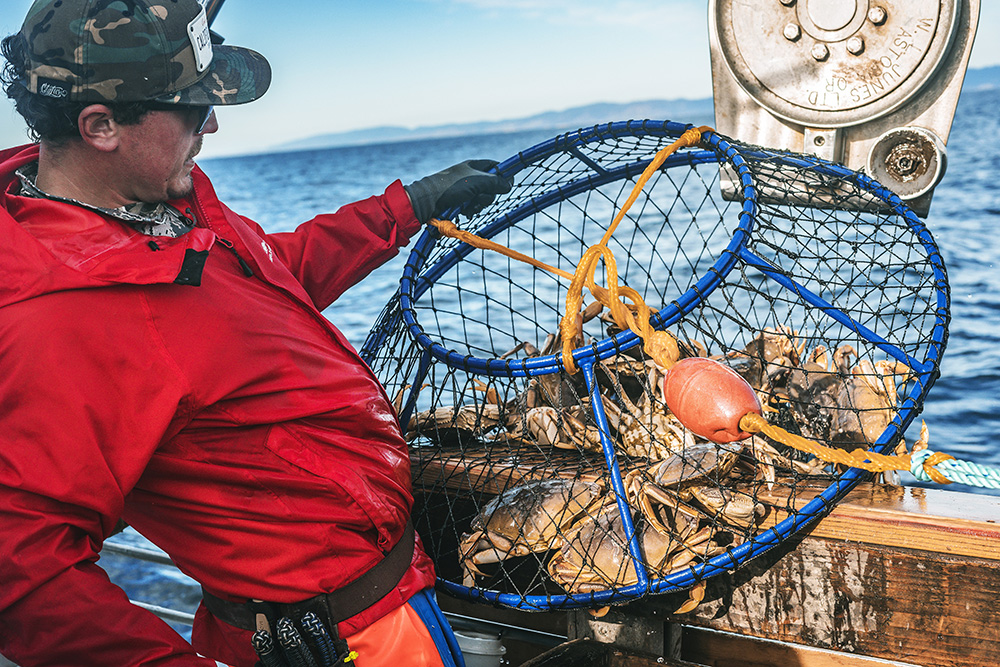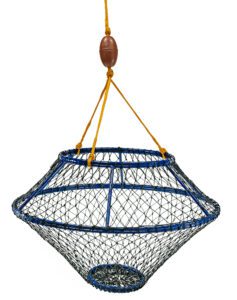
Here are two trends that aren’t so new in crabbing and crab equipment, but they are worth noting: more catch per pot, and bigger equipment, are the preferred options; West Coast operators are just about as busy dealing with regulations as they are fishing.
Crabbing is an important part of the growing seafood market. The global seafood market is expected to see a compound annual growth rate of 1.36%—from $720.76 billion in 2023 to $771.17 billion in 2029, largely due to the rising public awareness about the vital role of fish as a food group in healthy diets, according to a report from Mordor Intelligence.
West Coast fishermen are a big part of those figures, and while operators in key crabbing states like Alaska, Washington and Oregon must put significant money and resources into adhering to regulations, fishermen in California in particular are buying equipment with regulations firmly in mind, according to Jeffrey Russell, general manager at Pitbull Tackle in Cotati, Calif.
Regulations
When asked for his thoughts on the biggest trends in crabbing equipment, chief among the changes he is seeing in tackle and customer interests are the regulations that West Coast fishermen must deal with.
Since large whales periodically become entangled in active or derelict fishing gear, regulators have become increasingly involved in fishing equipment regulation. Between 2000 and 2013, an average of 10 confirmed whale entanglements were reported each year—in 2015 and 2016, there was an increase in the number of confirmed entanglements associated with the Dungeness crab commercial trap fishery compared with previous years, according to NOAA Fisheries.
Dungeness crab fishing season typically runs from November through June, but Dungeness crab fishing closed in April in central and southern California to prevent entanglements from returning Humpback whales to state waters. Entanglements have become enough of an issue that some operations in the area began testing “whale-safe” gear, or “ropeless” fishing gear, in hopes the state will authorize the alternative next season.
The interest from the regulators in protecting whales has driven demand and innovation in gear, according to Russell.
“The biggest trend in the industry in California, aside from the growing popularity of crab snares, is the regulation changes from crab pots to hoop nets,” Russell said.
“In the past, anglers were allowed to use crab pots, but now the (California Department of Fish and Wildlife) has banned crab pots, and only allows hoop nets for a large part of the season,” he added.
“This change in regulations is based upon the presence of whales, and whale entanglements with crab rope,” he continued. “Since hoop nets are not designed to be soaked as long as crab pots, and are checked frequently by the fishermen, they are considered by CDFW to be safer for whales.”
Andy Endo, West Coast Sales Manager with Promar & Ahi USA in Gardena, Calif., has also seen regulations dictate customer demand.
Rubber wrapped stainless pots are in consistent demand each year, he said, adding that in “California, the hoop nets have become the standard during early season with special restrictions in place.”

Endo recommends the company’s rubber wrapped stainless-steel pots, as well as their Ambush XLHD hoop nets.
“Our stainless-steel pots have a 30-inch diameter and stand 10-inches tall, and weigh 20 pounds,” he said.
The pots also have two tunnels and a tending door on top. The Ambush XLHD hoop nets are 36-inches in diameter and 9.5-inches tall and weigh 23 pounds.
“These hoop nets have become the go-to net during early season Dungeness fishing,” Endo said.
Endo was referring to fishing in Northern California, where the CDFW put restrictions on pots during the beginning of the season and only allowed hoop nets to be used.
Such sudden changes in regulations are requiring manufacturers to be ever quicker to adapt to be ready for suddenly changing regulations and consumer needs, he said.
“Next season looks to be status quo, but we always have to be ready to pivot due to regulation changes,” Endo added.
Beside regulations, the costs to pay crew, buy fuel and bait, and deal with other expenses, are driving changes in demand for equipment, according to Russ Mullins, owner of Longsoaker Fishing Systems Inc. in Ferndale, Wash.
“Rising operational costs have pushed fishers to find less expensive ways to land more product,” Mullins said.
His company’s receiving more interest in equipment to help operations deal with these costs by improving efficiencies. The Longsoaker timed-release bait containers are among their current top sellers, because they yield bigger catches. According to Mullins, between 25% and 45% more crab per catch is typical.

The containers enable targeted release of un-soaked, dry, bait into the gear in the middle of the pre-soak, bad weather, town-soak or normal gear hauling cycle after the initial bait is shot.
“The Longsoaker timed release bait containers continue to be a hot commodity,” he added.
Timer options range from eight hours to five days, which Mullins said is a feature that enables re-baiting under a variety of fishing situations like storms, town soaks or when the initial bait starts to fade or become depleted.
Franken Tunnel
The “Franken Tunnel” is the newest development from Eureka, Calif.-based Custom Crab Pots.
Seth Griggs, co-owner of the business, said the “Franken Tunnel” is a new design with a patent pending designed for catching both king crab and Dungeness.
The design is ramp-less, so crabs don’t have to crawl up, but instead walk straight into the pot—eliminating impediments and resistance, according to Griggs.
The company tested the pot against two commonly used pot types in California, Oregon and Washington, but have yet to test it in Alaska—the Bering Sea, Aleutian Islands, and Gulf of Alaska produce on average in excess of one-third of total U.S. crab catches on average, according to the Alaska Department of Fish and Game.
According to Griggs, the Franken Tunnel was catching a 12-crab average compared with standard nylon tunnels at roughly an eight-crab average and wire tunnels at a three-crab average.
“The Franken Tunnel is what we would consider the best style pot we make,” Griggs said.
Styles
Griggs said style can be a difference-maker, and nylon tunnels are currently the most popular and in demand pot styles.
“A lot of guys are going for nylon tunnels,” Griggs added.
Size is another strong preference for fishermen, but the size of the gear in demand depends entirely on where a vessel is crabbing.
“Guys out of southeast only one like a 45- to 55-pound pot,” he said. “Puget Sound guys want light gear, but then you’ve got everybody else that wants at least an 80- to 90-pound pot or up.”
Harvey Ives, an owner of Trilogy Crab Pots in Bellingham, Washington, is also seeing greater demand for heavier pots and pots with more doors.
Simply put, four doors enable more crabs to get into traps, while heavier pots are more popular because fishermen are going into shallower waters as they are fishing later in the season to beef up their catch, according to Ives.
“They can catch more crabs in shallower water because you’re not taking so long running rope,” Ives added.
He said sales of four-door pots are running about 20% above sales of two-door pots.
“They’re purchasing the four doors,” Ives said.
Russell, with Pitbull Tackle, is seeing more customers ask for the company’s Crab Collar Castable Snare.
“I’m not just saying this because I work here,” Russell said. “It is honestly the furthest casting, and most effective snare on the market. It has a snap that allows you to add additional weight, and the shape allows it to generate lift while flying through the air when casted.”
Don Jergler has been a professional journalist for more than 25 years, covering insurance, real estate and more. He spent two decades as a reporter at several daily newspapers, then entered business-to-business reporting. His freelance work has appeared in the Los Angeles Times, Long Beach Post, Orange County Register and numerous B2B publications. He’s currently the Western Region editor of Insurance Journal.
